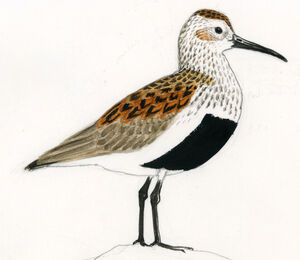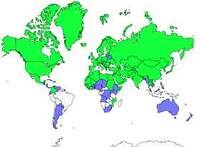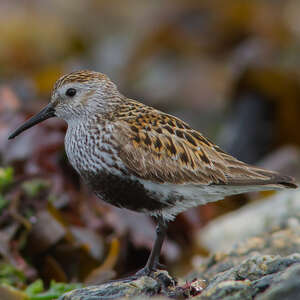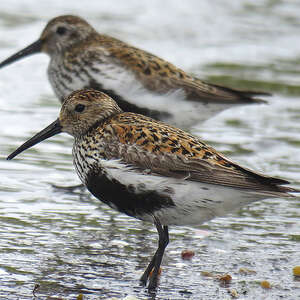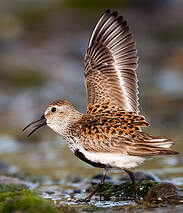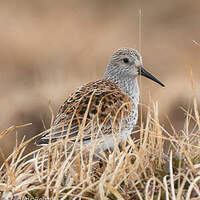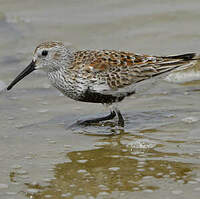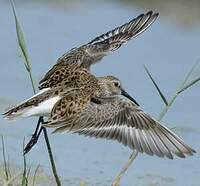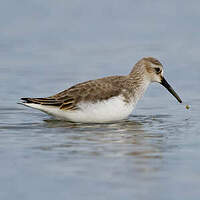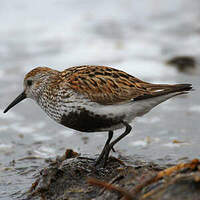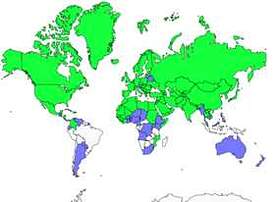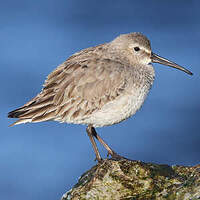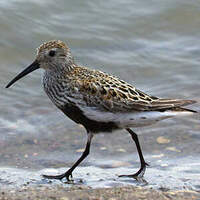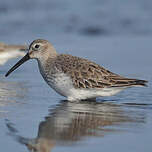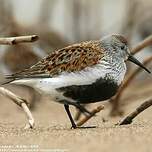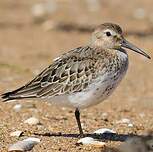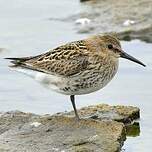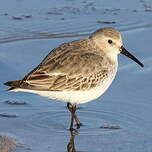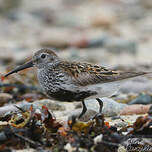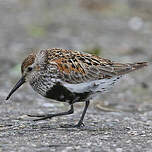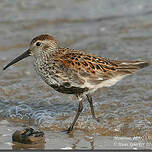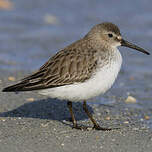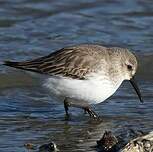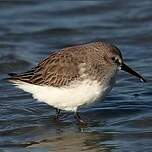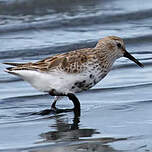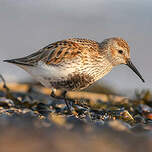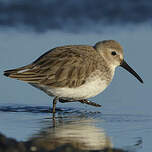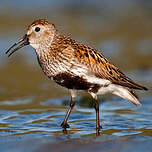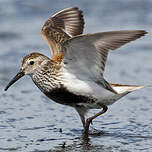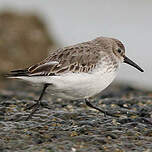Dunlin
Calidris alpina - Bécasseau variable
Identification
Dunlin is the most common of European waders, such that it is used as a reference for the identification of other small waders and especially sandpipers. Its silhouette and behavior can help its identification. It is fairly short-legged and moves its body horizontally with a slightly hunched back. At rest, it stands up, but with a very short and slightly cramped neck. The species has nine subspecies that have very noticeable plumage differences. We will focus here on the alpina subspecies, the most European.
The breeding adult is identifiable at first sight by its tricolor plumage. The upper parts appear very reddish from a distance, as does the cap. When viewed up close in detail, one can see that, in addition to the dominant red, they also show black and white. Each feather is reddish, with a black center and white at the end. The underparts are black and white. A wide black area covers the lower chest and upper belly while the white covers the throat, the upper chest, the flanks, the lower belly and the under-tail coverts. The white throat and upper chest are speckled / streaked with grayish-black. If necessary, its beak would confirm the species. Black beak always slightly longer than the head and more or less curved downwards. The legs, fairly short, are black. Sexual dimorphism is slight. The plumage is slightly less clearly colored in the female and its beak is slightly longer.
The inter-breeding adult is so different in appearance that one could doubt that it is a bird of the same species. Black and red have completely disappeared. On the other hand, white has invaded all the underparts.The upper part is a grey that appears uniform from afar. Up close, one can see that the feathers have a darker line along the spine. The cap is dark. The breast is more or less streaked in brownish tones. It could be confused with a Dunlin Wintering Shorebird which also has a long and curved bill and upper parts of a similar appearance. However, in winter, the two species do not coexist, the shorebird then being in Africa south of the Sahara.
The juvenile is closer in appearance to the adult in summer. Like the adult, it has a reddish tinged plumage. However, it is quite easily distinguished by its new plumage and the appearance of the upper and lower parts. The upper coverts are blackish brown and bordered by white or red, giving the whole a dark and scaly aspect. The wing covers are clearly fringed with light beige. The lower parts are a bit turbulent. Indeed, blackish spots on the lower sides and sides of the abdomen evoke the black plate of the adult and can lead to errors about age. You might think you were dealing with a transitional plumage adult but the upper parts bring us back to reality. Furthermore, the chest is very streaked with blackish brown. But this plumage is practically only visible on the breeding grounds as it starts to give way to the 1st winter plumage before departing on migration. In the migratory stops in September-October, juveniles are recognized by their juvenile plumage on top and the blackish spots on the flanks that persist. The bird with the complete first winter plumage resembles the wintering adult, but its wing covers and secondary remiges are clearly fringed with light beige, which breaks the uniformity of the top.
Subspecific information 10 subspecies
- Calidris alpina alpina (n Scandanavia to nw Siberia)
- Calidris alpina arctica (ne Greenland)
- Calidris alpina schinzii (se Greenland, Iceland, the British Isles to s Scandinavia and the Baltic)
- Calidris alpina centralis (nc to ne Siberia)
- Calidris alpina sakhalina (e Russia to the Chukotsk Pen.)
- Calidris alpina actites (Sakhalin I.. off se Russia.)
- Calidris alpina kistchinski (Sea of Okhotsk to Kuril Is. and Kamchatka)
- Calidris alpina arcticola (nw Alaska to nw Canada)
- Calidris alpina pacifica (w and s Alaska)
- Calidris alpina hudsonia (c Canada)
Foreign names
- Bécasseau variable,
- Correlimos común,
- pilrito-de-peito-preto,
- Alpenstrandläufer,
- havasi partfutó,
- Bonte Strandloper,
- Piovanello pancianera,
- kärrsnäppa,
- Myrsnipe,
- pobrežník čiernozobý,
- jespák obecný,
- Almindelig Ryle,
- suosirri,
- Bontstrandloper,
- territ variant,
- Lóuþræll,
- biegus zmienny,
- parastais šņibītis,
- spremenljivi prodnik,
- Чернозобик,
- ハマシギ,
- 黑腹滨鹬,
- นกชายเลนท้องดำ,
- 黑腹濱鷸,
Voice song and call
The usual flight call is a typical rolling cry of variable length, trrrrriii. It may be repeated. It is diagnostic of the species. On the breeding grounds, the singing is somewhat of a call in tone. It is a rapid sequence of rolling notes, pleasant but sometimes a bit harsh, tru tru tru tru tru... or riu riu riu riu riu riu... or variations on the theme.
Habitat
During the breeding season, the Dunlin frequents the circumpolar tundra, the high moor and heaths in the more hilly regions further south, but also the lowland marshes in the north. In winter, they form large flocks on coastlines and sheltered estuaries, on the intertidal zone, salt marshes, lagoons, salt flats, as well as the muddy banks of freshwater bodies and inland marshes.
Behaviour character trait
Outside the nesting season, the Dunlin has a strong flock instinct. At this time of year, the bands gathering in search of food can consist of hundreds or even thousands of individuals. In the spring, pairs start to form and males begin to mark their territory by making flights of parade. The male first quickly ascends, then flies in a stationary or undulating fashion in the wind. This display is accompanied by singing.
Dietfeeding habits
In summer, the Dunlin feeds on various insects in marshes and moorlands, as well as spiders, earthworms. During migration and in winter, it captures a wide variety of invertebrates, small polychaete worms, small molluscs, crustaceans, and occasionally, small fish. It loves grassy rocks as much as the soft silt which it quickly probes with small pecks. On harder ground, it first spots its prey which it captures with greater precision.
Reproduction nesting
The female lays 4 green eggs spotted with brown which she deposits in a scratched cup, usually well hidden in the vegetation. The incubation, which lasts 21 to 22 days, is ensured by both partners. The chicks are nidifugous and quickly leave the nest. They are able to fly after 19 to 21 days.
Geographic range
The Dunlin is a holarctic species that breeds in the Arctic in North America, Greenland, Iceland, and continuously in Eurasia. It also nests in northern British Isles and around the Baltic.
Its winter range is disjoint. It is mostly coastal. The species winters on the Pacific coast of the three North American states and on the Atlantic coast of the USA. Across the Atlantic, it can be found on the coasts of the North Sea and the Ocean, from the Benelux to Guinea-Bissau, around the Mediterranean, along the Nile and around the Red Sea, in Anatolia, around the Persian Gulf and off the north coast of the Indian Ocean, in the north of the Indian continent, in Vietnam, in southeast China, in Korea, and in Japan.
Threats - protection
Sources of information
- IOC World Bird List (v14.2), Gill, F and D Donsker (Eds). 2024-04-18.
- Guide des limicoles d'Europe, d'Asie et d'Amérique du Nord, D. Taylor
- Shorebirds, an identification guide to the waders of the world, Peter Hayman, John Marchant Tony Prater
- Birds of the World, The Cornell Lab of Ornithology
- xeno-canto, Sharing bird sounds from around the world,
Other sources of interest
 Specification sheet created on
24/07/2023 by Jean François
Specification sheet created on
24/07/2023 by Jean FrançoisTranslation by AI Oiseaux.net
© 1996-2025 Oiseaux.net
- Accipitriformes
- Aegotheliformes
- Anseriformes
- Apodiformes
- Apterygiformes
- Bucerotiformes
- Caprimulgiformes
- Cariamiformes
- Casuariiformes
- Charadriiformes
- Ciconiiformes
- Coliiformes
- Columbiformes
- Coraciiformes
- Cuculiformes
- Eurypygiformes
- Falconiformes
- Galliformes
- Gaviiformes
- Gruiformes
- Leptosomiformes
- Mesitornithiformes
- Musophagiformes
- Nyctibiiformes
- Opisthocomiformes
- Otidiformes
- Passeriformes
- Pelecaniformes
- Phaethontiformes
- Phoenicopteriformes
- Piciformes
- Podargiformes
- Podicipediformes
- Procellariiformes
- Psittaciformes
- Pterocliformes
- Rheiformes
- Sphenisciformes
- Steatornithiformes
- Strigiformes
- Struthioniformes
- Suliformes
- Tinamiformes
- Trogoniformes

